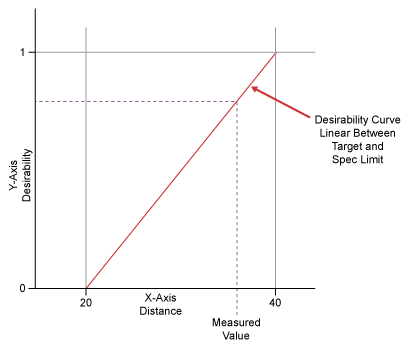
Based on the desirability function, using batting average, home runs, runs batted in (RBIs), All Star Game appearances and Gold Glove awards all weighted equally, Ron Santo, a third baseman for the Chicago Cubs from 1960 to 1973, should be a member of the National Baseball Hall of Fame. An understanding of the desirability function can be used to prove this point; it is also used in determining how well certain variables are meeting customer needs and is therefore an important skill for Six Sigma practitioners.
Calculating Desirability Using Simultaneous Optimization
What is desirability? It is a single number that describes how well, in this case, a particular third baseman comes to meeting the targets for all requirements simultaneously. The math in the desirability score card requires practitioners to know what the customer wants and what they will accept, known as voice of the customer (VOC); and what can be delivered and with how much variation, known as voice of the process (VOP).
In their article “Simultaneous Optimization of Several Response Variables” (1980), G. Derringer and R. Suich described a simultaneous optimization technique that used the desirability function. This same function can be used to help select the most desirable third basemen.
To use this approach, each measured parameter (yi) must be converted into a individual desirability (di). This function has the range 0 < di < 1. If the parameter yi is at its target, di =1. If the parameter yi is outside the specified limits, di = 0. Total desirability (D) is the geometric average of all the individual desirability, di, meaning:
D = (d1*d2*d3*dm)1/m
where m is the number of parameters measured.
It is important to recognize that when an individual desirability goes to 0, the total desirability becomes 0. There are three desirability functions, depending on the objective:
- Maximizing desirability
- Minimizing desirability
- Setting to a target between an upper limit and a lower limit
The formulas for each are as follows:


A graph illustrating the desirability curve derived from the target function is shown in Figure 1. The measured value is translated to d, desirability for the condition where weight = 1 and the value is to be maximized. If the weight were less than 1, the desirability curve would bow to the bottom right. If the desirability curve were greater than 1, the curve would bow to the upper left.
Ron Santo: Desirable Candidate
Back to baseball. A number of variables represent the desirability for admittance to the Hall of Fame (Table 1).
| Table 1: Target Variables for Admittance to National Hall of Fame | ||||
| Requirement | Target | LSL | USL | Importance |
| Batting average | 0.300 | 0.200 | N/A | 1 |
| Home runs | 300 | 100 | N/A | 1 |
| RBI | 1000 | 200 | N/A | 1 |
| All Star Game appearances | 10 | 1 | N/A | 1 |
| Golden Gloves awarded | 10 | 1 | N/A | 1 |
It is possible to calculate Santo’s overall desirability, and those of other third basemen admitted to the Hall of Fame, by comparing the players’ statistics with the target numbers (Tables 2). Players are given a 0 in the individual parameters where they do not meet the lower specification limits, as described in the desirability function.
| Table 2: Overall Desirability of Six Top Third Basemen | ||||||||||||||||
| Process Data and Comparison to Requirements for Ron Santo | Data and Comparison for Eddie Mathews | Data and Comparison for Brooks Robinson | Data and Comparison for Wade Boggs | Data and Comparison for Mike Schmidt | Data and Comparison for George Kell | |||||||||||
| Requirement | Target | LSL | USL | Importance | Mean | d | Mean | d | Mean | d | Mean | d | Mean | d | Mean | d |
| Batting average | 0.300 | 0.200 | N/A | 1 | 0.277 | 0.77 | 0.271 | 0.71 | 0.267 | 0.67 | 0.328 | 1.00 | 0.267 | 0.67 | 0.306 | 1.00 |
| Home runs | 300 | 100 | N/A | 1 | 342 | 1.00 | 512 | 1.00 | 268 | 0.84 | 118 | 0.09 | 548 | 1.00 | 78 | 0.00 |
| RBI | 1000 | 200 | N/A | 1 | 1331 | 1.00 | 1453 | 1.00 | 1357 | 1.00 | 1014 | 1.00 | 1595 | 1.00 | 870 | 0.84 |
| All Star Game appearances | 10 | 1 | N/A | 1 | 9 | 0.89 | 12 | 1.00 | 18 | 1.00 | 12 | 1.00 | 12 | 1.00 | 10 | 1.00 |
| Golden Gloves awarded | 10 | 1 | N/A | 1 | 5 | 0.44 | 0 | 0.00 | 16 | 1.00 | 2 | 0.11 | 10 | 1.00 | 0 | 0.00 |
|
Overall desirability |
0.79 | 0.00 | 0.89 | 0.40 | 0.92 | 0.00 | ||||||||||
Here is a graphical comparison of Santo’s performance to current Hall of Fame third basemen (Figure 2).

Clearly, when objectively compared to other great Hall of Fame third basemen, Ron Santo should be in the Hall of Fame.